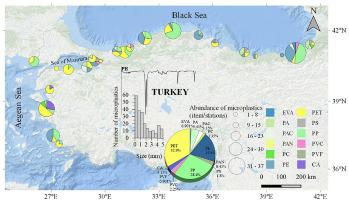Chemosphere ( IF 8.1 ) Pub Date : 2020-07-08 , DOI: 10.1016/j.chemosphere.2020.127570 Kenan Gedik 1 , Ahmet Raif Eryaşar 1

|
Plastics profoundly threatens ecological balance in marine ecosystems across the globe in the current era of industrialization. Microplastics (MP), in particular, can pose risks reaching humans through the food web via various marine organisms. Among these organisms, since they are consumed as a whole, mussels are vital vectors of MP transfer during human consumption. Hence, here we analyzed MP pollution in Mediterranean mussel (Mytilus galloprovincialis) sampled from 23 different locations all along the Turkish coasts of the Black Sea, Sea of Marmara, and the Aegean Sea. After digestion of the mussels with H2O2, the micro-particles were determined under a stereomicroscope and characterized by confirming with FTIR analyses. 48% of the sampled mussels were found to have MPs. The average MP abundance was 0.69 item/mussel and 0.23 item/g fresh weight (fw) of soft tissue. Morphology was ordered as follows: fragments (67.6%)> fibers (28.4%)> films (4.05%). The dominant size of MPs was detected less than 0.5 mm (26.58%). 12 different polymers have been identified by FTIR and PET (32.9%), PP (28.4%), and PE (19.4%) were found to constitute 80% of the total MPs. The annual average exposure amount for mussel consumers in Turkey was estimated as 1918 MPs item/per year. Even though international organizations such as FAO, JECFA, or EU have not declared permissible limits, our data may inform human health uptake of MP ingestion via mussels. This data might also serve as a reference data-set for further MP monitoring research in Turkish and European Seas.
中文翻译:

沿土耳其海岸收集的地中海贻贝(Mytilus galloprovincialis)的微塑性污染概况。
在当前的工业化时代,塑料严重威胁着全球海洋生态系统的生态平衡。尤其是,微塑料(MP)可能会构成通过各种海洋生物通过食物网到达人类的风险。在这些生物中,由于贻贝是整体食用的,所以贻贝是人类食用期间MP转移的重要载体。因此,在这里我们分析了从黑海,马尔马拉海和爱琴海的土耳其沿岸23个不同地点采样的地中海贻贝(Mytilus galloprovincialis)中的MP污染。用H 2 O 2消化贻贝后,在立体显微镜下测定微粒,并通过FTIR分析确认其特征。发现抽样的贻贝中有48%具有MP。平均MP丰度为0.69项/贻贝和0.23项/ g软组织鲜重(fw)。形态排序如下:碎片(67.6%)>纤维(28.4%)>薄膜(4.05%)。检测到MP的主要尺寸小于0.5毫米(26.58%)。FTIR鉴定出12种不同的聚合物,其中PET(32.9%),PP(28.4%)和PE(19.4%)占总MP的80%。土耳其贻贝消费者的年平均暴露量估计为1918 MPs /每年。即使诸如FAO,JECFA或EU之类的国际组织未声明允许的限值,我们的数据也可能会告知人类健康通过贻贝摄入MP的情况。











































 京公网安备 11010802027423号
京公网安备 11010802027423号